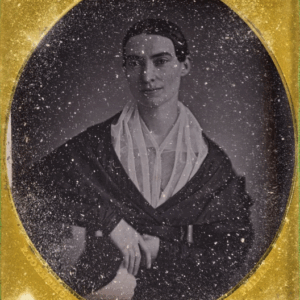JTF (just the facts): A total of 17 black and white photographic works, framed in white and unmatted, and hung against white walls in the narrow single room gallery space. All of the works are made up of gelatin silver prints, from single images to groups of 4, 5, or 7 panels. Physical sizes of individual panels range from 4×5 to 16×20, and all of the works are unique. (Installation images below.)
Comments/Context: When we use the word “experimental” to describe a photograph, what we often really mean to say is that it is avant-garde, or chance-driven, or riskier in some manner than most of what we’re used to seeing; using this word introduces a satisfying kind of artistic spookiness, like peeking into the unknown. But when we say that Caleb Charland’s new works are experimental, we’re actually making a much more precise assertion. His photographs are experimental in the scientific sense; he starts with a hypothesis, builds an apparatus, runs some tests (whose results are his artworks), and ultimately draws some conclusions about the elemental forces (both physical and chemical) that have generated the visible outcomes. The line between art and science is muddy, but Charland’s process of exploring that grey area is altogether exacting and meticulous.
All of the works on view in this show start with a burning candle, and iteratively examine how liquid drips of wax fall onto photographic paper, how the red wax filters the light exposure, and how the spots of wax affect the paper as it goes through various chemical processing steps. Each run through is like a stand alone experiment, where the starting variables are tweaked and optimized to get alternate results.
Charland’s multi-panel works are made by suspending the burning candle from a dangling overhead rope, effectively turning it into a pivoting pendulum, which can then be swung back and forth or rotated in circles, dripping blobs of wax on the paper laid out below as the candle melts. Physics and math enthusiasts will likely revel in the underlying formulas Charland’s artworks make visible (Berenice Abbott would be proud), but to the lay visitor, the drips are lonely on the extreme edges (at the tops of the arc), becoming denser and denser as the pendulum slows down and regains equilibrium at the center (hanging straight down); here the falling wax puddles into wider pools and the last few drops create splatters and sideways blast ejections like hot lava. Depending on the how Charland plays with the processing steps or employs different papers, the background outcomes range from mottled ghostly light grey to rich charcoal, with the spots taking on values across the full spectrum from white to black (along with some detours into slight tints of yellow or brown). Like Chris McCaw’s sine wave sun and moon tracings, these particular works have a sense of marking and measuring time, the chance outcomes on paper the direct result of specific time and distance settings at the start.
Most of the other works on view are single page experiments, where the sheet has been tilted at an angle and the wax droplets have been allowed (or perhaps encouraged) to slide into elongated ovals, the entire sheet sprinkled like a rain shower. Once again, Charland is experimenting with a wide tonal range, each unique iteration a bit yellower here or a bit darker there depending on the conditions; individual cracked droplets become earrings, or old time striped Christmas ornaments, or comets with flickering tails. These works are the loose kin of all-over, improvisational drip painting, freckled and pock marked with unseen gestural control.
With these works and others from his preceding projects, Charland is quietly carving himself a defensible niche in the process-centric world of photographic abstraction, bringing a more earnest science-centric perspective to the dialogue. His photographs feel ready to embrace the beautiful mysteries of science, leaning on constructs that generate the right conditions for artistic serendipity. When the combinations fall into just the right place, his ordinary red wax becomes the vehicle for some jewel-like discoveries.
Collector’s POV: The works in this show range in prices from $1000 for the smallest single images to $10200 for the largest multi-panel works. Charland’s work has not yet reached the secondary markets, so gallery retail remains the best option for those collectors interested in following up.












